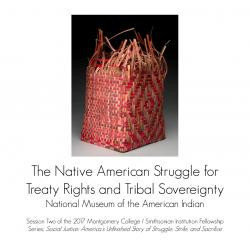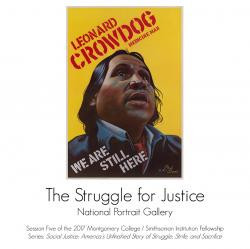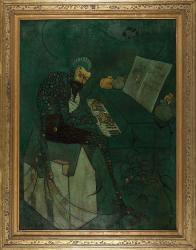Tess Porter
User Experience Strategist (she/her)
Smithsonian Office of Educational Technology
I'm the former User Experience Strategist at the Smithsonian Office of Educational Technology. Here, I focused on the use of digital museum resources to support teaching and learning. My work draws on my experience as a museum educator, digital analyst, usability researcher, and content designer. I hold a B.A. in Anthropology and a B.A. in Art History from University Colorado Boulder, and an M.S. in Museums and Digital Culture with an Advanced Certificate in User Experience from Pratt Institute.
Tess Porter's collections
Bracero Program: Step In, Step Out, Step Back
<p>In this activity, students will examine a painting of Mexican guest-workers, known as braceros, involved in the Bracero Program (1942-1964), the largest guest-worker program in US history. Started as a temporary war measure to address labor demands in agriculture and railroads, the program allowed Mexican nationals to take temporary agricultural work in Texas, New Mexico, Arizona, California, and 24 other states. By the time the program ended in 1964, over 4.6 million work contracts were awarded.
</p>
<p>Using a Project Zero Global Thinking Routine - "Step In - Step Out - Step Back" - students will examine the perspectives of those depicted in the painting, consider what it means to take the perspectives of others, and explore avenues and methods to learn more about Braceros. Resources for learning more about the Bracero program are located at the end of the collection and include: <em>Bittersweet Harvest</em>, a digital exhibition about the Bracero Program; the <em>Bracero History Archive</em>, which includes oral histories, objects, and more; and a Learning Lab collection of photographs documenting the Bracero Program.</p>
<p>Keywords: laborer, immigration, work, migration, migrant workers, agriculture, reform, politics, government, photojournalism, activity, inquiry strategy, global competency, global competence, latino, chicano, 1940s, 40s, 1950s, 50s, 1960s, 60s</p><p>#EthnicStudies</p>
 Tess Porter
Tess Porter
6
Bob Dylan and Woody Guthrie: Teaching Resources
<p>This topical collection gathers resources about Bob Dylan, one of the most influential American music artists of the 20th century, and Woody Guthrie, who greatly influenced the work of Dylan and other folk artists. Ideas for classroom application located in "Notes to Other Users." Resources include images, videos, music, and a lesson plan.</p>
<p>Tags: minnesota; hibbing; folk music; medieval music; ballad; #SmithsonianMusic<br /></p>
 Tess Porter
Tess Porter
15
Social Justice: National Museum of the American Indian Resources
<p>This collection previews the second seminar of the 2017 Montgomery College / Smithsonian Institution Fellowship seminar series, <em>The Native American Struggle for Treaty Rights and Tribal Sovereignty.</em> Three National Museum of the American Indian staff members will lead this event: Mark Hirsch, David Penney, and Colleen Call Smith.</p>
<p>Resources included in this collection have been chosen by the presenters for participants to explore before the seminar itself.</p>
<p>#MCteach</p>
 Tess Porter
Tess Porter
7
Suffrage Pin: Object Analysis
<p>Using the Project Zero Visible Thinking routine "See Think Wonder," this activity explores the struggle of suffragists during the American suffrage movement through deep analysis of one object - a pin, worn by suffragist Alice Paul, in the shape of a jail door with a heart-shaped lock. Pins such as these were given in a ceremony to suffragists who were imprisoned as a result of the 1917 pickets. Includes the pin, an article discussing the history behind the pin, and multiple photographs suffragist picketers.</p>
<p>Keywords: women's rights, suffrage, suffragette, protest, reform, civil rights, equal rights, alice paul, jailed for freedom, pin, national women's party, nwp, voting, vote</p>
 Tess Porter
Tess Porter
6
Dong Kingman
<p>This collection focuses on Dong Kingman (1911-2000), an American watercolorist best known for his urban and landscape paintings, magazine covers, and scenery work for multiple films. Dong Kingman was born in Oakland, California, to Chinese immigrants and moved to Hong Kong when he was a child. There, he studied both Asian and European painting techniques before returning to the United States during the Great Depression. Artwork in this collection includes works created for the Works Progress Administration, the NASA Art Program, and Time magazine. Also included is a short documentary, directed by two-time Academy Award winner James Wong Howe, and Dong Kingman's obituary from the New York Times.</p>
<p>This collection is not comprehensive but rather provides a launching point for research and study. <br /></p>
<p><em>This Smithsonian Learning Lab collection received Federal support from the Asian Pacific American Initiatives Pool, administered by the Smithsonian Asian Pacific American Center.</em></p>
<p>Keywords: chinese american, china<br /></p>
<p>#APA2018<br /></p>
 Tess Porter
Tess Porter
21
Bessie Smith: Examining Portraiture
<p>This teacher's guide provides portraits and analysis questions to enrich students' examination of Bessie Smith, the "Empress of the Blues" and one of the most influential blues singers in history. Includes the video "Defining Portraiture: How are portraits both fact and fiction?" and the National Portrait Gallery's "<em>Reading" Portraiture Guide for Educators, </em>both of which provide suggestions and questions for analyzing portraiture. Also includes a video clip of Bessie Smith performing "St. Louis Blues" in 1929 and a post from the National Museum of African American History and Culture discussing her and other LGBTQ African Americans of the Harlem Renaissance.</p>
<p>Consider:</p>
<ul><li>What do these portraits have in common? How are they different?</li><li>How are these portraits both fact and fiction?</li><li>How do these portraits reflect how she wanted to be seen, or how others wanted her to be seen? Consider for what purpose these portraits were created.</li><li>Having listened her music, does the portrait capture your image of Bessie Smith? Why, or why not?</li><li>If you were creating your own portrait of Bessie Smith, what characteristics would you emphasize, and why?</li></ul><p>Keywords: singer, musician, 20s, 30s, American, Tennessee, #BecauseOfHerStory, #SmithsonianMusic</p>
 Tess Porter
Tess Porter
11
Investigating: Civil War Portraits
<p>In this student activity, students will investigate nine portraits of people involved in the Civil War, both from the Union and the Confederacy. Through these portraits, students will gain an understanding of: experiences of people on both sides of the war; why these people are seen as historically significant; and how portraiture can communicate how a person wanted to be seen, or how others wanted them to be seen. Included with each portrait is a video that explains the historical significance of the person depicted. Activity extension ideas can be found by clicking "Read More."</p>
<p>Big Ideas: </p>
<ul><li>Why are these people, and the developments they shaped, seen as historically significant? </li><li>How does portraiture communicate how a person wanted to be seen, or how others wanted them to be seen?</li></ul><p>Keywords: thomas stonewall jackson, william tecumseh sherman, john pelham, elmer e ellsworth, george armstrong custer, jefferson davis, abraham lincoln, clara barton</p>
 Tess Porter
Tess Porter
10
Civil Rights Sculpture: Claim Support Question
<p>Using the Project Zero Visible Thinking routine "Claim Support Question," a routine for clarifying truth claims, students will examine a portrait of Rosa Parks, a prominent civil rights activist whose refusal to give up her bus seat to a white passenger prompted the 1955-56 Montgomery bus boycott. After discussing the portrait with their peers, students will learn more about the arrest this sculpture depicts by reading the original police report, with notes by a Smithsonian curator.</p>
<p>Created for the 2016 National Portrait Gallery Summer Teacher Institute.</p>
<p>Keywords: african-american, black, civil rights movement, female, woman, women, segregation, NAACP, justice, arrest, #BecauseOfHerStory</p>
 Tess Porter
Tess Porter
3
Dissolution of Native American Territory 1885-1905
<p>This student activity examines what events, including the Dawes Act of 1887, contributed to the change in Native American reservation boundaries over time. Includes a video discussing 19th century views toward Native Americans, maps of reservation territory in 1885, 1895, 1905, and 1965, discussion questions, and an opportunity to learn more using an interactive map.</p>
<p>Big idea: Understand how boundaries of Native American reservations have changed over time, and what events lead to the alteration of borders.</p>
<p>Keywords: American Indian, western expansion</p>
 Tess Porter
Tess Porter
8
African American Artists and Ancient Greek Myth: Teacher's Guide
<p>This teacher's guide explores how myths transcend time and place through three modern paintings by African American artists who reinterpret Ancient Greek myth to comment on the human experience. Collection includes three paintings and a lesson plan published by the Smithsonian American Art Museum, which includes background information on myths and artists, as well as activity ideas. Also includes a video about the artist Romare Bearden and his series 'Black Odyssey.' The video details his artistic process, the significance of storytelling in his art, and the lasting importance of 'Black Odyssey.'</p>
<p><strong>Objectives:</strong></p>
<ol><li>Demonstrate that myths transcend time and place</li><li>Recognize the use of classical myth in contemporary art</li><li>Discuss myth as commentary on human experience</li></ol>
<p>Keywords: greece, alma thomas, bob thompson,</p>
 Tess Porter
Tess Porter
5
Compare and Contrast: Personal Perspectives in Portraiture
<p>In this activity, students will explore how portraits reflect both the personality of the subject and the artist's personal view of the subject. They will examine two portraits - both painted by James McNeill Whistler of his patron (and eventually ex-patron) Frederick Richards Leyland. Using looking strategies, students will compare and contrast the artist's perspective of his subject before connecting the portraits to music as a final activity.</p><p>Big Idea: How do portraits reflect both the personality of the subject and the artist’s view of their subject? How can visual art and music communicate similar messages?</p>
<p>This collection was created for the District of Columbia Public Schools (DCPS) Arts Professional Development Day. It was created in collaboration with the <a href="https://learninglab.si.edu/profile/freersackler_education">Education Department at the Freer Gallery of Art and Arthur M. Sackler Gallery</a>.</p>
<p>Keywords: Peacock Room</p>
 Tess Porter
Tess Porter
6
Flashcard Activity: Conflict, Identity, and Place in American Art
<p>This collection contains a selection of artworks related to the themes of conflict, identity, and place. They may be used for a variety of purposes; here, we use them as a catalyst for discussion. In small groups or as a classroom, have students select one artwork they find meaningful or interesting and discuss the following:</p>
<ol><li>Why did you pick this artwork? </li><li>What do you see? Name specific aspects of the artwork you notice.</li><li>What do you think about what you see?</li><li>What does this artwork make you wonder? </li><li><em>Optional</em>: How might the artwork connect to the themes of conflict, identity, and place?</li></ol>
<p>
</p>
<p>This activity works equally well online or using printed flashcards (see <a href="https://learninglab.si.edu/collections/flashcard-activity-conflict-identity-and-place-in-american-art/wCjeBXbgRgExR2Py#r/883001">the resource tile</a>). You may also replace or pair the above activity with a Project Zero Thinking Routine found in the final section of the collection. </p>
<p><em>This Smithsonian Learning Lab collection contains artwork selected by <a href="https://learninglab.si.edu/profile/666">Phoebe Hillemann</a>, Teacher Institutes Educator at the Smithsonian American Art Museum, to be featured in the 2018 Smithsonian American Art Museum Summer Institute for Teachers, "Teaching the Humanities through Art." The activity is adapted from Project Zero's See / Think / Wonder routine.</em></p>
<p>Keywords: printable, flash card, project zero visible thinking routine, New Jersey Principals and Supervisors Association, NJPSA, saam</p>
 Tess Porter
Tess Porter
51






